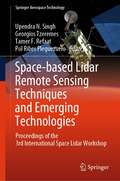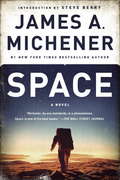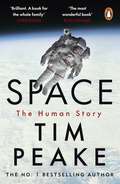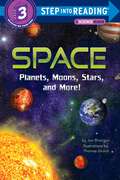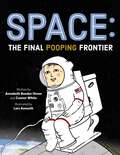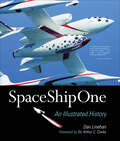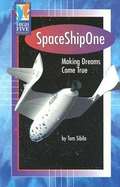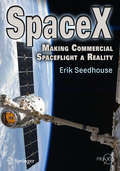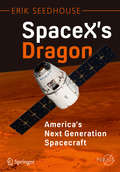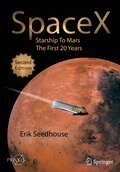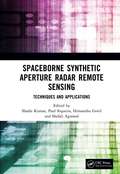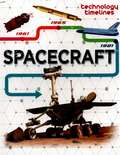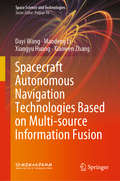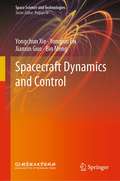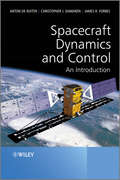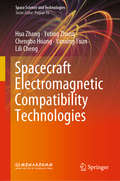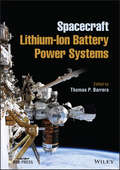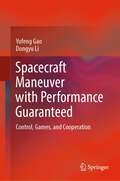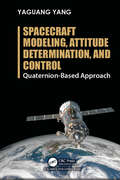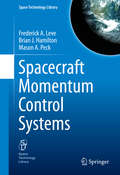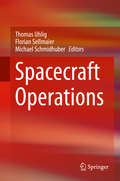- Table View
- List View
Space-based Lidar Remote Sensing Techniques and Emerging Technologies: Proceedings of the 3rd International Space Lidar Workshop (Springer Aerospace Technology)
by Upendra N. Singh Georgios Tzeremes Tamer F. Refaat Pol Ribes PleguezueloThis book gathers the latest advances, innovations, and applications in the field of space lidar missions, techniques, and technologies, as presented at the 3rd International Workshop on Space-Based Lidar Remote Sensing Techniques and Emerging Technologies (LIDAR), held in Milos Island, Greece, on June 18–23, 2023. It covers highly diverse topics such as space-based lidar techniques and methodologies; challenges experienced in space lidar missions; planning of new space earth observation lidar missions, including monitoring of topography, cryosphere, biomass, greenhouse and trace gases clouds, aerosols; exploration lidars, including entry, decent and precision landing, as well as hazard avoidance for Mars & Lunar landers missions; results and plans for simulations, airborne experiments and demonstrations as precursors for space missions; emerging space lidar technologies, particularly in lasers, optics, electronics and detectors as well as space lidar reliability and influencing factors, such as effects of the space environment. Written by leading scientists and technologists from government agencies, industries and universities, and selected by means of a rigorous international peer-review process, the contributions highlight numerous exciting ideas that will spur novel research directions and foster multidisciplinary collaborations.
Space: A Novel
by James A. Michener Steve BerryAlready a renowned chronicler of the epic events of world history, James A. Michener tackles the most ambitious subject of his career: space, the last great frontier. This astounding novel brings to life the dreams and daring of countless men and women--people like Stanley Mott, the engineer whose irrepressible drive for knowledge places him at the center of the American exploration effort; Norman Grant, the war hero and U.S. senator who takes his personal battle not only to a nation, but to the heavens; Dieter Kolff, a German rocket scientist who once worked for the Nazis; Randy Claggett, the astronaut who meets his destiny on a mission to the far side of the moon; and Cynthia Rhee, the reporter whose determined crusade brings their story to a breathless world. BONUS: This edition includes an excerpt from James A. Michener's Hawaii. Praise for Space "A master storyteller . . . Michener, by any standards, is a phenomenon. Space is one of his best books."--The Wall Street Journal "A novel of very high adventure . . . a sympathetic, historically sound treatment of an important human endeavor that someday could be the stuff of myth, told here with gripping effect."--The New York Times Book Review "Space is everything that Michener fans have come to expect. Without question, the space program's dramatic dimensions provide the stuff of great fiction."--BusinessWeek "Michener is eloquent in describing the actual flights into space, as well as the blazing, apocalyptic re-entry of the shuttle into earth's atmosphere."--The New York Times
Space: A thrilling human history by Britain's beloved astronaut Tim Peake
by Tim PeakeFrom bestselling author and British astronaut Tim Peake, an inspirational human history of space travel, from the Apollo missions to our future forays to Mars. The Right Stuff for a new generation.'This book is brilliant - once in a blue moon. A book for the whole family.' Chris Evans, Virgin Radio'The most wonderful book ... Tim Peake is a historian and encyclopaedia of space.’ Rory Stewart'An extraordinary book. For anyone - even if you’re not interested in Space. If you’re interested in human stories and the human character - this is delightful.' BBC Breakfast'A fascinating, detailed, playful book drawn from extensive research – Peake met seven Apollo astronauts, Russian cosmonauts and various other space technicians – as well as his considerable personal experience. Lifts the lid on what space is like: the dedication and sacrifice; the politics and pantomime; the practicalities and the peril; the glory and fame; the adjustment back to normal life.' iPaper'A thrilling human history of space' Daily Mirror'The bible of space travel' Chris Moyles, Radio XAs seen in the major TV series Secrets of Our Universe with Tim Peake.Only 656 people in human history have left Earth. In Space: The Human Story, astronaut Tim Peake traces the lives of these remarkable men and women who have forged the way, from Yuri Gagarin to Neil Armstrong, from Valentina Tereshkova to Peggy Whitson.Full of exclusive new stories, and astonishing detail only an astronaut would know, the book conveys what space exploration is really like: the wondrous view of Earth, the surreal weightlessness, the extraordinary danger, the surprising humdrum, the unexpected humour, the newfound perspective, the years of training, the psychological pressures, the gruelling physical toll, the thrill of launch and the trepidation of re-entry. The book also examines the surprising, shocking and often poignant stories of astronauts back on Earth, whose lives are forever changed as they readjust to terra firma.Publication of the book comes on the eve of NASA's plans to return to the moon, fifty years after an astronaut last walked on the lunar surface. In 2024 the Artemis II mission will send four astronauts to orbit the moon. In 2025 Artemis III will send the first woman and the first person of colour to step on the lunar surface. What will separate these upcoming moonwalkers from the legendary Apollo crews? Does it still take a daring-do attitude, super-human fitness, intelligence, plus the 'Right-stuff' - a fabled grace under pressure? And how will astronauts travel even further - to Mars and beyond? Space: The Human Story reveals all.
Space: Planets, Moons, Stars, And More! (Step into Reading)
by Joe RhatiganLearn about our solar system in this Step 3 Science Reader packed with NASA photos and space facts! Step into Reading, the most trusted name in early readers, delivers an introduction to the final frontier that kids can read themselves! For up-to-date information (including about Pluto and its fellow dwarf planets) and stellar photos and illustrations, kids eager for mind-blowing nonfiction need look no further! Step 3 Readers feature engaging characters in easy-to-follow plots about popular topics. They are ideal for children who are ready to read on their own.
Space: The Final Pooping Frontier
by Connor White Annabeth Bondor-StoneDiscover the down and dirty scientific history of astronauts pooping in space in this funny and factual picture book.Everybody poops. So, what’s an astronaut to do when hurtling through space with zero gravity and zero privacy? Go boldly.This is a scientific history of pooping in space. From the earliest NASA missions up through the innovative results of their recent Space Poop Challenge design competition, we’ll see the evolution of pooping on the final frontier. With fascinating facts and a few mishaps and discarded technologies along the way, we’ll learn why it’s so hard to deal with waste management in space.
SpaceShipOne: An Illustrated History
by Dan Linehan“One of the most remarkable accomplishments in our conquest of gravity.” — Sir Arthur C. Clarke In April, 2003, a company called Scaled Composites introduced SpaceShipOne to the world. SpaceShipOne: An Illustrated History chronicles the development of the world’s first commercial manned space program—aprogram that includes an airborne launcher (the White Knight), a space ship (SpaceShipOne), rocket propulsion, avionics, simulator, and full ground support. With ample illustrations, photographs, and behind-the-scenes information, SpaceShipOne provides a full picture of this classified project. The story of SpaceShipOne combines the adventurous spirit of Charles Lindbergh, the entrepreneurial drive of Howard Hughes, and the urgency of the space race at the height of the Cold War.
SpaceShipOne: Making Dreams Come True
by Tom SibilaDescribes the spacecraft known as SpaceShipOne, and explains its adventures into space in 2004.
SpaceX
by Erik SeedhouseThis first account of commercial spaceflight's most successful venture describes the extraordinary feats of engineering and human achievement that have placed SpaceX at the forefront of the launch industry and made it the most likely candidate for transporting humans to Mars. Since its inception in 2002, SpaceX has sought to change the space launch paradigm by developing a family of launch vehicles that will ultimately reduce the cost and increase the reliability of space access tenfold. Coupled with the newly emerging market for governmental, private, and commercial space transport, this new model will re-ignite humanity's efforts to explore and develop space. Formed in 2002 by Elon Musk, the founder of PayPal and the Zip2 Corporation, SpaceX has already developed two state-of-the-art new launch vehicles, established an impressive launch manifest, and been awarded COTS funding by NASA to demonstrate delivery and return of cargo to the ISS. This book describes how simplicity, low-cost, and reliability can go hand in hand, as promoted in the philosophy of SpaceX. It explains how, by eliminating the traditional layers of internal management and external sub-contractors and keeping the vast majority of manufacturing in house, SpaceX reduces its costs while accelerating decision making and delivery, controls quality, and ensures constant liaison between the design and manufacturing teams.
SpaceX's Dragon: America's Next Generation Spacecraft
by Erik SeedhouseDragon V2 is a futuristic vehicle that not only provides a means for NASA to transport its astronauts to the orbiting outpost but also advances SpaceX's core objective of reusability. A direct descendant of Dragon, Dragon V2 can be retrieved, refurbished and re-launched. It is a spacecraft with the potential to completely revolutionize the economics of an industry where equipment costing hundreds of millions of dollars is routinely discarded after a single use. It was presented by SpaceX CEO Elon Musk in May 2014 as the spaceship that will carry NASA astronauts to the International Space Station as soon as 2016. SpaceX's Dragon - America's Next Generation Spacecraft describes the extraordinary feats of engineering and human achievement that have placed this revolutionary spacecraft at the forefront of the launch industry and positioned it as the precursor for ultimately transporting humans to Mars. It describes the design and development of Dragon, provides mission highlights of the first six Commercial Resupply Missions, and explains how Musk hopes to eventually colonize Mars.
SpaceX: Starship to Mars – The First 20 Years (Springer Praxis Books)
by Erik SeedhouseLearn about commercial spaceflight’s most successful startup in this fully updated book, which follows the extraordinary feats of engineering and human achievement that have placed SpaceX at the forefront of the launch industry and positioned it as the most likely candidate for transporting humans to Mars. This second edition emphasizes SpaceX's much-hyped manned mission to the Red Planet. With a plethora of new material gathered from 2013 to the present, the text offers the most up-to-date portrait of the maverick band of scientists and engineers producing some of the most spectacular aviation triumphs of the 21st century. Topics covered in this book include: all CRS flights, the challenges of developing retro-propulsion, and the pathway towards realizing the Falcon Heavy and BFR. In addition, the chapters describe SpaceX’s emphasis on simplicity, low-cost, and reliability, and the methods the company employs to reduce its costs while speeding up decision-making and delivery. Detailing the Falcon 1, Falcon 9 and Falcon Heavy launch vehicles, the book shows how SpaceX is able to offer a full spectrum of light, medium, and heavy lift launch capabilities to its customers and how it is able to deliver spacecraft into any inclination and altitude, from low Earth orbit to geosynchronous orbit to planetary missions. This book is the perfect go-to guide on SpaceX for anybody working or interested in the commercial space arena.
Spaceborne Synthetic Aperture Radar Remote Sensing: Techniques and Applications
by Shashi Kumar Paul Siqueira Himanshu Govil Shefali AgrawalThis book provides basic and advanced concepts of synthetic aperture radar (SAR), PolSAR, InSAR, PolInSAR, and all necessary information about various applications and analysis of data of multiple sensors. It includes information on SAR remote sensing, data processing, and separate applications of SAR technology, compiled in one place. It will help readers to use active microwave imaging sensor-based information in geospatial technology and applications.This book: Covers basic and advanced concepts of synthetic aperture radar (SAR) remote sensing Introduces spaceborne SAR sensors Discusses applications of SAR remote sensing in earth observation Explores utilization of SAR data for solid earth, ecosystem, and cryosphere, including imaging of extra-terrestrial bodies Includes PolSAR and PolInSAR for aboveground forest biomass retrieval, as well as InSAR and PolSAR for snow parameters retrieval This book is aimed at researchers and graduate students in remote sensing, photogrammetry, geoscience, image processing, agriculture, environment, forestry, and image processing.
Spacecraft (Technology Timelines Ser.)
by Tom JacksonSpace is not that far away. It starts at 100 km (62 miles) above the surface of Earth. However, fewer than 550 people have travelled into space and most have stayed close to our planet. The first humans flew into space in 1961, but the technology that got them there is hundreds of years old.
Spacecraft Autonomous Navigation Technologies Based on Multi-source Information Fusion (Space Science and Technologies)
by Dayi Wang Maodeng Li Xiangyu Huang Xiaowen ZhangThis book introduces readers to the fundamentals of estimation and dynamical system theory, and their applications in the field of multi-source information fused autonomous navigation for spacecraft. The content is divided into two parts: theory and application. The theory part (Part I) covers the mathematical background of navigation algorithm design, including parameter and state estimate methods, linear fusion, centralized and distributed fusion, observability analysis, Monte Carlo technology, and linear covariance analysis. In turn, the application part (Part II) focuses on autonomous navigation algorithm design for different phases of deep space missions, which involves multiple sensors, such as inertial measurement units, optical image sensors, and pulsar detectors. By concentrating on the relationships between estimation theory and autonomous navigation systems for spacecraft, the book bridges the gap between theory and practice. A wealth of helpful formulas and various types of estimators are also included to help readers grasp basic estimation concepts and offer them a ready-reference guide.
Spacecraft Dynamics and Control (Space Science and Technologies)
by Yongchun Xie Yongjun Lei Jianxin Guo Bin MengThis book presents up-to-date concepts and design methods relating to space dynamics and control, including spacecraft attitude control, orbit control, and guidance, navigation, and control (GNC), summarizing the research advances in control theory and methods and engineering practice from Beijing Institute of Control Engineering over the years. The control schemes and systems based on these achievements have been successfully applied to remote sensing satellites, communication satellites, navigation satellites, new technology test satellites, Shenzhou manned spacecraft, Tianzhou freight spacecraft, Tiangong 1/2 space laboratories, Chang'e lunar explorers, and many other missions. Further, the research serves as a guide for follow-up engineering developments in manned lunar engineering, deep space exploration, and on-orbit service missions.
Spacecraft Dynamics and Control: An Introduction
by James R. Forbes Christopher Damaren Anton H. de RuiterProvides the basics of spacecraft orbital dynamics plus attitude dynamics and control, using vectrix notation Spacecraft Dynamics and Control: An Introduction presents the fundamentals of classical control in the context of spacecraft attitude control. This approach is particularly beneficial for the training of students in both of the subjects of classical control as well as its application to spacecraft attitude control. By using a physical system (a spacecraft) that the reader can visualize (rather than arbitrary transfer functions), it is easier to grasp the motivation for why topics in control theory are important, as well as the theory behind them. The entire treatment of both orbital and attitude dynamics makes use of vectrix notation, which is a tool that allows the user to write down any vector equation of motion without consideration of a reference frame. This is particularly suited to the treatment of multiple reference frames. Vectrix notation also makes a very clear distinction between a physical vector and its coordinate representation in a reference frame. This is very important in spacecraft dynamics and control problems, where often multiple coordinate representations are used (in different reference frames) for the same physical vector. Provides an accessible, practical aid for teaching and self-study with a layout enabling a fundamental understanding of the subject Fills a gap in the existing literature by providing an analytical toolbox offering the reader a lasting, rigorous methodology for approaching vector mechanics, a key element vital to new graduates and practicing engineers alike Delivers an outstanding resource for aerospace engineering students, and all those involved in the technical aspects of design and engineering in the space sector Contains numerous illustrations to accompany the written text. Problems are included to apply and extend the material in each chapter Essential reading for graduate level aerospace engineering students, aerospace professionals, researchers and engineers.
Spacecraft Electromagnetic Compatibility Technologies (Space Science and Technologies)
by Hua Zhang Yuting Zhang Chengbo Huang Yanxing Yuan Lili ChengThis book explores key techniques and methods in electromagnetic compatibility management, analysis, design, improvement and test verification for spacecraft. The first part introduces the general EMC technology of spacecraft, the electromagnetic interference control method and management of electromagnetic compatibility. The second part discusses the EMC prediction analysis technique and its application in spacecraft, while the third presents the EMC design of spacecraft modules and typical equipment. The final two parts address spacecraft magnetic design testing technologies and spacecraft testing technologies. The book also covers the program control test process, the special power control unit (PCU), electric propulsion, PIM test and multipaction testing for spacecraft, making it a valuable resource for researchers and engineers alike.
Spacecraft Lithium-Ion Battery Power Systems (IEEE Press)
by Thomas P. BarreraSpacecraft Lithium-Ion Battery Power Systems Provides Readers with a Better Understanding of the Requirements, Design, Test, and Safety Engineering of Spacecraft Lithium-ion Battery Power Systems Written by highly experienced spacecraft engineers and scientists working at the forefront of the aerospace industry, Spacecraft Lithium-Ion Battery Power Systems is one of the first books to provide a comprehensive treatment of the broad area of spacecraft lithium-ion battery (LIB) power systems technology. The work emphasizes the technical aspects across the entire lifecycle of spacecraft LIBs including the requirements, design, manufacturing, testing, and safety engineering principles needed to deploy a reliable spacecraft LIB-based electrical power system. A special focus on rechargeable LIB technologies as they apply to unmanned and crewed Earth-orbiting satellites, planetary mission spacecraft (such as orbiters, landers, rovers and probes), launch vehicle, and astronaut spacesuit applications is emphasized. Using a system’s engineering approach, the book bridges knowledge gaps that typically exist between academic and industry practitioners. Key topics of discussion and learning resources include: Detailed systematic technical treatment of spacecraft LIB-based electrical power systems across the entire LIB lifecycle Principles of lithium-ion cell and battery design and test, LIB sizing, battery management systems, electrical power systems, safety engineering, ground and launch-site processing, and on-orbit mission operations Special topics such as requirements engineering, qualification testing, thermal runaway hazards, dead bus events, life cycle testing and prediction analyses, on-orbit LIB power system management, and spacecraft EPS passivation strategies Comprehensive discussion of on-orbit and emerging space applications of LIBs supporting various commercial, civil, and government spacecraft missions such as International Space Station, Galileo, James Webb Telescope, Mars 2020 Perseverance Rover, Europa Clipper, Cubesats, and more Overall, the work provides professionals supporting all aspects of the aerospace marketplace with key knowledge and highly actionable information pertaining to LIBs and their specific applications in modern spacecraft systems.
Spacecraft Maneuver with Performance Guaranteed: Control, Games, and Cooperation
by Dongyu Li Yufeng GaoFacing future-oriented aerospace applications, large-scale space construction and on-orbit services have rapidly developed. In such emerging and increasingly complex spacecraft maneuvering and control tasks, more precise control accuracy and higher performance guarantees need to be fully considered due to the need for safe close rendezvous movements.This book is dedicated to solving the aerospace system’s performance guaranteed and precise control challenges with the expected transient and strict steady-state constraints. It is designed so that the aerospace closed-loop system can theoretically meet the pre-defined or prescribed performance requirements with the simple parameter selection. Furthermore, the expected performance constraints or indicators of the aerospace system time-domain performance response, such as settling time, overshoot, steady-state error, and state amplitude, will be directly guaranteed in the control design. Moreover, this book systematically proposes a series of spacecraft performance guaranteed control algorithms based on the practical situation of the aerospace system. For individual spacecraft, control algorithms that consider practical problems such as control task requirements, settling time constraints, transient performance normalization, input command constraints, and optimization faced by the on-orbit spacecraft are proposed to achieve the precise control objectives of the system under constraints and various complex situations. For the pre-combination and post-combination control of multiple spacecraft, game algorithms based on performance guarantees are proposed and thoroughly discussed. For spacecraft formations, control algorithms that consider full-state constraints, nonlinear uncertainties, output feedback, and collision avoidance are proposed.This book provides the theoretical basis and simulation experience for scholars and engineers to develop high-performance, high-precision spacecraft control algorithms. Furthermore, it hopes that these will contribute to the development of the world’s aerospace technology.
Spacecraft Maximum Allowable Concentrations for Selected Airborne Contaminants: Volume 3
by Subcommittee on Spacecraft Maximum Allowable ConcentrationsThe National Aeronautics and Space Administration (NASA) has measured numerous airborne contaminants in spacecraft during space missions because of the potential toxicological hazards to humans that might be associated with prolonged spacecraft missions.This volume reviews the spacecraft maximum allowable concentrations (SMACs) for various contaminants to determine whether NASA's recommended exposure limits are consistent with recommendations in the National Research Council's 1992 volume Guidelines for Developing Spacecraft Maximum Allowable Concentrations for Space Station Contaminants.
Spacecraft Maximum Allowable Concentrations for Selected Airborne Contaminants: Volume 3
by Subcommittee on Spacecraft Maximum Allowable ConcentrationsThe National Aeronautics and Space Administration (NASA) has measured numerous airborne contaminants in spacecraft during space missions because of the potential toxicological hazards to humans that might be associated with prolonged spacecraft missions.This volume reviews the spacecraft maximum allowable concentrations (SMACs) for various contaminants to determine whether NASA's recommended exposure limits are consistent with recommendations in the National Research Council's 1992 volume Guidelines for Developing Spacecraft Maximum Allowable Concentrations for Space Station Contaminants.
Spacecraft Maximum Allowable Concentrations for Selected Airborne Contaminants: Volume 4
by National Research CouncilThe National Academies Press (NAP)--publisher for the National Academies--publishes more than 200 books a year offering the most authoritative views, definitive information, and groundbreaking recommendations on a wide range of topics in science, engineering, and health. Our books are unique in that they are authored by the nation's leading experts in every scientific field.
Spacecraft Maximum Allowable Concentrations for Selected Airborne Contaminants: Volume 5
by National Research Council of the National AcademiesNASA is aware of the potential toxicologic hazards to crew that might be associated with prolonged spacecraft missions. Despite major engineering advances in controlling the atmosphere within spacecraft, some contamination of the air appears inevitable. NASA has measured numerous airborne contaminants during space missions. As the missions increase in duration and complexity, ensuring the health and well-being of astronauts traveling and working in this unique environment becomes increasingly difficult. As part of its efforts to promote safe conditions aboard spacecraft, NASA requested the National Research Council to develop guidelines for establishing spacecraft maximum allowable concentrations (SMACs) for contaminants and to review SMACs for various spacecraft contaminants to determine whether NASA's recommended exposure limits are consistent with the guidelines recommended by the committee. This book is the fifth volume in the series Spacecraft Maximum Allowable Concentrations for Selected Airborne Contaminants, and presents SMACs for acrolein, C3 to C8 aliphatic saturated aldehydes, C2 to C9 alkanes, ammonia, benzene, carbon dioxide, carbon monoxide, 1,2-dichloroethane, dimethylhydrazine, ethanol, formaldehyde, limonene, methanol, methylene dichloride, n-butanol, propylene glycol, toluene, trimethylsilanol, and xylenes.
Spacecraft Modeling, Attitude Determination, and Control: Quaternion-Based Approach
by Yaguang YangThis book discusses all spacecraft attitude control-related topics: spacecraft (including attitude measurements, actuator, and disturbance torques), modeling, spacecraft attitude determination and estimation, and spacecraft attitude controls. Unlike other books addressing these topics, this book focuses on quaternion-based methods because of its many merits. The book lays a brief, but necessary background on rotation sequence representations and frequently used reference frames that form the foundation of spacecraft attitude description. It then discusses the fundamentals of attitude determination using vector measurements, various efficient (including very recently developed) attitude determination algorithms, and the instruments and methods of popular vector measurements. With available attitude measurements, attitude control designs for inertial point and nadir pointing are presented in terms of required torques which are independent of actuators in use. Given the required control torques, some actuators are not able to generate the accurate control torques, therefore, spacecraft attitude control design methods with achievable torques for these actuators (for example, magnetic torque bars and control moment gyros) are provided. Some rigorous controllability results are provided. The book also includes attitude control in some special maneuvers, such as orbital-raising, docking and rendezvous, that are normally not discussed in similar books. Almost all design methods are based on state-spaced modern control approaches, such as linear quadratic optimal control, robust pole assignment control, model predictive control, and gain scheduling control. Applications of these methods to spacecraft attitude control problems are provided. Appendices are provided for readers who are not familiar with these topics.
Spacecraft Momentum Control Systems
by Frederick A. Leve Brian J. Hamilton Mason A. PeckThe goal of this book is to serve both as a practical technical reference and a resource for gaining a fuller understanding of the state of the art of spacecraft momentum control systems, specifically looking at control moment gyroscopes (CMGs). As a result, the subject matter includes theory, technology, and systems engineering. The authors combine material on system-level architecture of spacecraft that feature momentum-control systems with material about the momentum-control hardware and software. This also encompasses material on the theoretical and algorithmic approaches to the control of space vehicles with CMGs. In essence, CMGs are the attitude-control actuators that make contemporary highly agile spacecraft possible. The rise of commercial Earth imaging, the advances in privately built spacecraft (including small satellites), and the growing popularity of the subject matter in academic circles over the past decade argues that now is the time for an in-depth treatment of the topic. CMGs are augmented by reaction wheels and related algorithms for steering all such actuators, which together comprise the field of spacecraft momentum control systems. The material is presented at a level suitable for practicing engineers and those with an undergraduate degree in mechanical, electrical, and/or aerospace engineering.
Spacecraft Operations
by Thomas Uhlig Florian Sellmaier Michael SchmidhuberThe book describes the basic concepts of spaceflight operations, for both, human and unmanned missions. The basic subsystems of a space vehicle are explained in dedicated chapters, the relationship of spacecraft design and the very unique space environment are laid out. Flight dynamics are taught as well as ground segment requirements. Mission operations are divided into preparation including management aspects, execution and planning. Deep space missions and space robotic operations are included as special cases. The book is based on a course held at the German Space Operation Center (GSOC).
